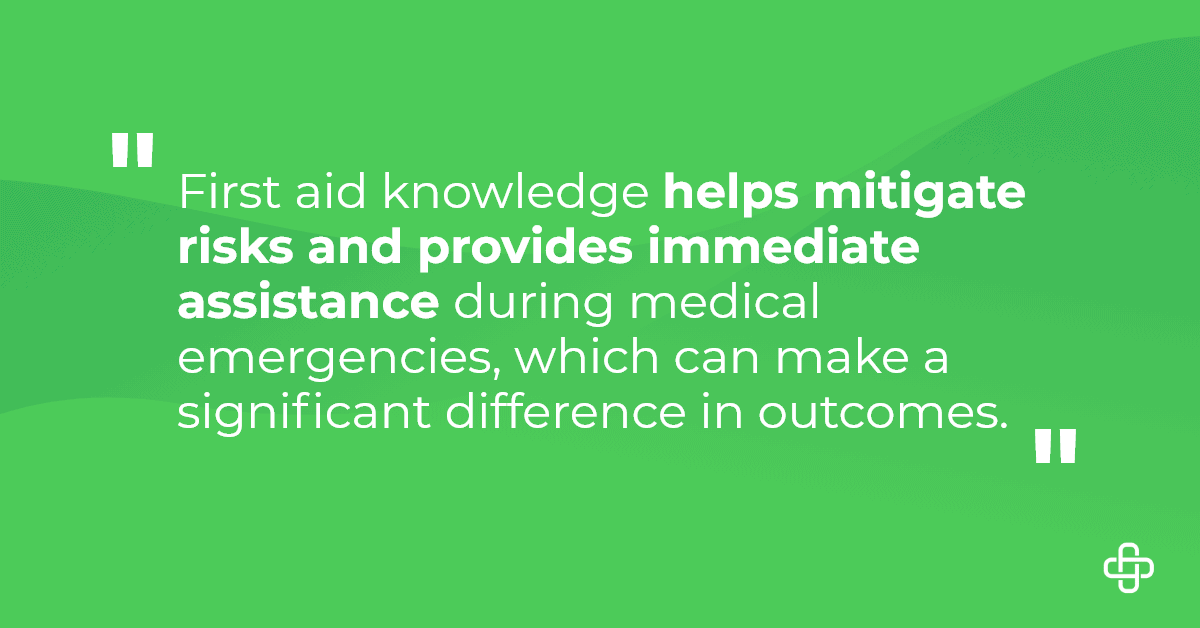Unexpected medical emergencies can turn an ordinary workday into a critical test of preparedness.

Understanding workplace first aid isn’t just a good thing; it is essential for ensuring workplace safety and peace of mind.
Introduction to Workplace First Aid: Why It Matters
Workplace safety is a shared responsibility, and knowing the basics of first aid is crucial.
First aid knowledge helps mitigate risks and provides immediate assistance during medical emergencies, which can make a significant difference in outcomes. It’s about reacting to incidents and proactively creating a safe environment where employees feel cared for and secure.
Consider this scenario—an employee sustains a cut while handling equipment. Immediate first aid can prevent infection and further complications. A well-prepared workplace fosters trust and demonstrates a commitment to employee welfare, boosting morale and reducing anxiety.
Investing in workplace first aid is a smart move that pays dividends to employee well-being and organizational reputation.
A workforce trained in first aid contributes to a culture of safety and readiness, ensuring that every team member feels empowered to act swiftly and effectively when needed.
Common Workplace Injuries and How to Prevent Them
Understanding the types of injuries that commonly occur in the workplace is the first step in prevention. Common injuries include:
- Slips
- Trips
- Falls
- Cuts
- Burns
- Strains
Each requires specific preventative measures to minimize its occurrence.
For instance, slips and falls can often be prevented by keeping walkways clear of clutter, ensuring proper lighting, and using slip-resistant mats. Regular safety audits can identify potential hazards and reinforce the use of protective gear where necessary.
Cuts and burns are more common in environments with machinery or hot surfaces. Ensuring machines are well-maintained and employees are trained to use them correctly reduces risk. Providing personal protective equipment (PPE), such as gloves, goggles, and aprons, can also be effective.
Poor posture and repetitive motions can lead to ergonomic injuries, like strains. Offering ergonomic work environments and encouraging regular breaks can help reduce these risks. Educational programs on proper lifting techniques and posture can also contribute to a safer work environment.
The Essentials of a Workplace First Aid Kit
A well-stocked first aid kit is a crucial component of workplace safety. To be effective, it must contain supplies that address a range of possible injuries and must be easily accessible to all employees.
OSHA specifies exact items that are mandatory for first aid kit for special industries which includes:
- Gauze pads (at least 4 x 4 inches)
- Two large gauze pads (at least 8 x 10 inches)
- Box adhesive bandages (band-aids)
- One package gauze roller bandage at least 2 inches wide
- Two triangular bandages
- Wound cleaning agent such as sealed moistened towelettes
- Scissors
- At least one blanket
- Tweezers
- Adhesive tape
- Latex gloves
- Resuscitation equipment such as resuscitation bag, airway, or pocket mask
- Two elastic wraps
- Splint
- Directions for requesting emergency assistance
Additionally, consider including a first-aid manual or quick-reference guide. This can provide step-by-step instructions for treating common injuries and ensure that even those with minimal training can administer care.
Regular checks and maintenance of the first aid kit ensure that supplies are replenished and up to date. Encouraging employees to familiarize themselves with the contents and location of the kits fosters a culture of preparedness and confidence in handling emergencies.
The Role of Employers in Ensuring a Safe Workplace
Employers should provide the necessary resources for first aid training and ensure that safety protocols are implemented and adhered to. They set the tone for a safety-first culture by leading by example and promoting ongoing education on workplace hazards.
HR professionals can facilitate training programs and ensure compliance with safety regulations. They serve as a bridge between employees and management, addressing safety concerns and promoting wellness initiatives.
Safety and risk managers are responsible for regular safety audits and risk assessments. Their insights help identify potential hazards and develop strategies to mitigate them. Implementing a robust incident reporting system allows for continuous improvement and adaptation of safety measures.
Axiom Medical’s Commitment to Workplace Safety
Axiom Medical stands as a steadfast ally in workplace safety, offering 24/7 support from dedicated nurse case managers who are pivotal in addressing injuries when they occur.
These experienced professionals proactively engage with employees to manage injuries at the first aid level, prioritizing swift recovery and facilitating a seamless return to work.
By providing immediate guidance and support, Axiom Medical empowers workforces to feel confident and prepared in the face of unexpected incidents.
Their comprehensive approach addresses current injuries and fosters a culture of awareness and readiness, ensuring employees are equipped with the knowledge and tools necessary to navigate challenges effectively.
Through this commitment, Axiom Medical strengthens the overall safety framework within organizations, reinforcing a proactive stance on employee health.
Conclusion
Empowering every workplace with basic first-aid knowledge is a game-changer. It transforms employees’ perception of safety and equips them with the tools to handle emergencies confidently.
Employers, HR professionals, safety managers, and risk managers all play vital roles in this mission. By collaborating and staying informed about legal requirements and best practices, they can ensure that their workplaces remain safe and welcoming environments for everyone.
To further enhance your understanding of workplace first aid, we invite you to watch the replay of Axiom Medical’s webinar, “Ready for Anything: Tackling Medical Crises at Work.”
Join us to learn how to respond effectively to common workplace emergencies and gain valuable insights into resources that every employee needs to stay prepared.
Don’t miss this opportunity to strengthen your team’s readiness–watch now.










